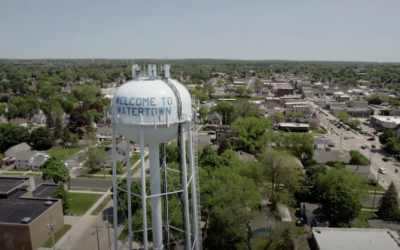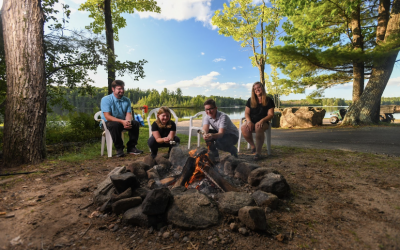As parents, we are both fortunate to be able to work in the same district where our children attend school. It’s a blessing that not all teachers are afforded. Teachers, as a whole, want a safe, nurturing, and rigorous educational environment for their students, and this is doubly true in our case. We want a place where we feel safe and excited to send our children, and we want that place to be Adams-Friendship High School.
Four years ago, thanks to the AWARE grant, our district invested in the social-emotional and mental health of our students. One of the ways they did this was by implementing Safe School Ambassadors (SSA).
Our students participate in an anonymous Youth Risk Behavior Survey to analyze the changes in student culture. The district uses this data to drive the direction for upcoming years. It focuses on a range of things from bullying, to attendance, and more. Not all of our data over the past few years has shown improvement in these areas, but we do have bright spots, including the fact that the percentage of students who report that bullying and harassment is a problem on school property has decreased by 10% since 2015. This is something to celebrate and, in part, is due to our SSA.
Watch this video to learn ways to give students the tools they need to prevent bullying and spread positivity in schools.
Students are a powerful force for change
However, the work isn’t done. Although we saw an 11% increase in students reporting a sense of belonging in their school from 2015-2017, in 2018 we saw a 7% decrease. This means that our ambassadors are making changes, but need more help. Our goal is to train more students in the upcoming years so that our reach is larger.
What most people don’t realize is that students are the biggest and most powerful force for change in our schools. And yet, we often make them the most underutilized resource. They see, hear, and know things that teachers and other adults in schools do not. They can intervene in ways adults can not. Kids decide what’s cool in school, so why not train them with strategies to make being kind cool again.
Kids are the future; SSA gives them the power to make positive cultural change in their school and it does it in a safe way. Kids might be reluctant to step in and stop an aggressor if they don’t know them well, but SSA allows kids to start first with themselves and next with their social group.
Strategies to empower action
The beauty of SSA is the training process. It’s an intense, interactive, two day training. Students and staff reflect upon personal experiences and participate in collaborative learning activities that build trust. We train the adults to become family group facilitators with the students as they become ambassadors.
During the training, students develop skills in observing, negotiating, interviewing, and reporting while staff learn to facilitate small family group meetings of 8-12 students. Throughout, we continually circle back to the seven strategies our ambassadors will use to intervene in student altercations. The power behind the strategies is that of the seven, only one requires adult intervention. The students use these simple strategies to tackle the different types of mistreatment: put downs, unwanted physical contact, acts against campus, exclusions, and intimidation. Many students who start SSA aren’t even sure what they’re getting into during training, but by the time they leave they’re ready to make the change they want to see in our school.
Ambassador Dallas King said, “I had no clue what SSA was until I was asked to join, and I am so glad I am able to have the opportunity to make a difference in my school and work with a great group of people on some amazing projects.”
Working from the inside out
With the rise of school violence (emotional and physical), schools have taken an outside-in approach. Since Columbine, schools have spent nearly a billion dollars to keep schools safe from outside threats. These are all important things, but we also need to work from the inside out.
Rick Phillips, the founder of Community Matters said, “Here’s what we’ve learned. You can most often keep the guns out, but you can’t keep the student out, and they bring in other types of weapons that get past adults and machines. Those are weapons of prejudice, stereotypes, and grudges from their neighborhood and values from home. And, it is these weapons that contribute to the many incidents that [teachers] have to deal with everyday.” We need to work with our students to change the climate. If we change the climate, we can directly impact other things like attendance, graduation rates, and academic success. Students who feel safe and welcome in a school come ready to learn.
Building a positive school culture
We make this a reality by running the meetings, but also by implementing projects for the school. We’ve started projects to help welcome our students; one of them is the “Sticky Note Project.” Ambassadors write positive affirmations on sticky notes such as “you’re wonderful.” Then, we anonymously cover the school with these notes, placing them on every locker. Students are greeted with a positive message just for them. It’s just one small thing to make our school a better place.
This process of building a positive school culture is a journey. There are no perfect systems and no perfect people. Our ambassadors aren’t perfect and aren’t disciplinarians. They’re just kids, stepping in to diffuse tension and trying to make their school better.
We know we have a long way to go, but we know that we’ve made progress. We see it in our ambassadors who step into situations they might have once just ignored. We see it in students who might walk away from a fight because their friend reminded them of the consequences. We see it in sticky notes on lockers instead of on the floor. We see it in teachers who facilitate family groups and share positive stories from their groups. And finally, we see it in the future of our school our own kids will attend.
Watch this video to learn ways to give students the tools they need to prevent bullying and spread positivity in schools.
Kimberly Etter is an English Teacher, Spectrum Academy Teacher, and yearbook advisor at Adams-Friendship High School. She earned her English BSE from the University of Wisconsin-Whitewater in 2007. She enjoys working with high school students and helping them reach their potential and become critical thinkers who want to change the world. Mrs. Etter enjoys spending time her her husband and three children. She co-manages Safe School Ambassadors with Mrs. Tissen.
Emily Tissen is a Special Education Teacher of students with Intellectual Disabilities at Adams-Friendship High School and co-manages the Safe School Ambassador program with Mrs. Etter as a Trainer of Trainers. She has earned a Master of Arts in special education cross-categorical ages 5-21 from Rockford College in Rockford, IL, and a Bachelor of Arts in elementary education, from Rockford College. She enjoys working with high school students and helping them to achieve their individual goals to become compassionate, honest and productive members of society. She is the proud mother of two high school students, Andy who is a sophomore and Jayme who is a freshman, both at AFHS.



